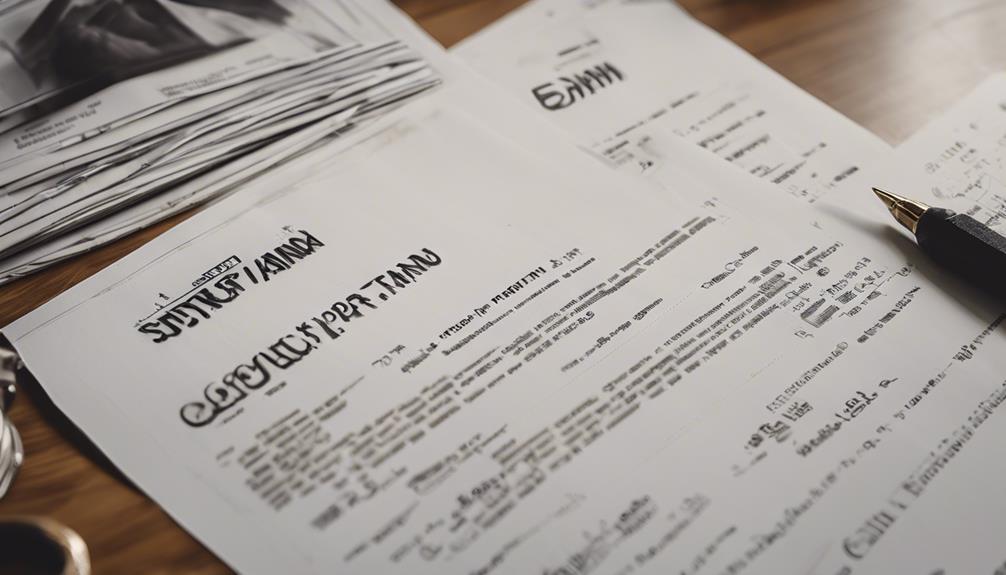To register a trademark in India, individuals and entities must prepare specific documents. Individuals or Sole Proprietors should have a copy of their logo, Form-48, proof of identity and address, and evidence establishing ownership and authenticity. For Companies and Partnerships, it requires documents like Aadhar Registration Certificate, Partnership Deed, and Incorporation Certificate, along with identity proofs. Startups benefit from a Certificate of Recognition from DPIIT and reduced fees. Trusts and Societies need trust deeds, registration certificates, and detailed information about trustees. Finally, all applicants must submit the trademark application form, a power of attorney, trademark specimen, description of goods or services, and proof of use. Explore further for detailed insights.
Key Takeaways
- Copy of logo and proof of identity are essential.
- Partnership Deed or Incorporation Certificate for company partnerships.
- Certificate of Recognition from DPIIT for startups.
- Trust Deed and Society Registration Certificate for trusts and societies.
- Trademark application form and specimen of the trademark are necessary for registration.
Individual or Sole Proprietor Documents
Individuals or sole proprietors seeking trademark registration in India must prepare specific documents, including a copy of their logo, Form-48, and proof of identity and address. These documents are essential for the registration process as they help establish ownership and authenticity.
The proof of identity and address is vital to verify the individual or sole proprietor's details. Form-48 is a form of authorization allowing a trademark attorney to file the application on behalf of the owner. The logo is a key element as it represents the brand and distinguishes it from others in the market.
As an individual or sole proprietor, having these documents in order is a critical first step towards protecting your intellectual property rights. By ensuring all the required paperwork is complete and accurate, you can streamline the trademark registration process and safeguard your brand effectively.
Company Partnership Requirements

For partnership firms seeking trademark registration in India, submitting specific documents is an essential requirement. The partnership deed or incorporation certificate is pivotal to establish the existence and authorization of the partnership for trademark registration online. Additionally, the Udyog Aadhar Registration Certificate is necessary for partnership firms to benefit from the reduced trademark registration fee applicable to small enterprises and startups. Ensuring that all partners' identity proofs and address proofs are provided along with the trademark registration application is crucial. Compliance with these document requirements is imperative for the successful registration of a trademark in India.
| Documents Required for Trademark Registration |
|---|
| Aadhar Registration Certificate |
| Partnership Deed |
| Incorporation Certificate |
| Identity Proof |
Startup Entity Documentation

Startups looking to register a trademark in India must provide a certificate of recognition from DPIIT to benefit from reduced registration fees. This certificate showcases the startup's acknowledgment under the Startup India initiative, enabling them to access various benefits and incentives offered by the government to foster entrepreneurship.
By presenting this certificate, startup entities can streamline the trademark registration process, making it more efficient and cost-effective. The DPIIT's certificate of recognition plays an important role in not only lowering trademark registration fees but also in demonstrating the startup's official status, opening doors to a range of support mechanisms and opportunities tailored to assist budding businesses.
Embracing the startup entity documentation requirements not only facilitates the trademark registration process but also signifies a commitment to leveraging the advantages and resources extended by the government to nurture the startup ecosystem in India.
Trust and Society Papers

Trust and Society papers play a vital role in the trademark registration process in India for entities operating as Trusts or Societies. These documents, such as the Trust Deed and Society Registration Certificate, are essential for establishing the legal existence of the entity seeking trademark registration. They serve as proof of the entity's formation and authorization to apply for trademark registration under the relevant laws.
Trust documents should include detailed information about trustees and their authority, while Society papers should demonstrate the registration under the Societies Registration Act. To guarantee a smooth process, accurate submission of complete Trust and Society papers is paramount. Failure to provide these documents in full and accurately may result in delays or rejection of the trademark registration application.
As such, it's essential for Trusts and Societies to meticulously prepare and submit all necessary paperwork for a successful registration process.
General Documents for Registration

Submitting essential documents is a critical step in the trademark registration process in India. The general documents required for registration include the trademark application form, power of attorney, specimen of the trademark, description of goods or services, and proof of use.
The trademark application form is important as it serves as the official request for registration, providing key details about the applicant and the trademark itself. Additionally, the power of attorney is necessary to authorize a representative to act on behalf of the applicant throughout the registration procedure.
Proof of use plays a significant role in demonstrating how the trademark is actively utilized in connection with specific goods or services, thereby reinforcing the application for registration. These original documents are essential for establishing ownership, offering a clear description of the trademark, and showcasing actual usage in commerce, all in alignment with Intellectual Property Rights regulations in India.
Frequently Asked Questions
What All Documents Are Required for Trademark Registration in India?
When registering a trademark in India, applicants must submit essential documents such as the trademark application form, power of attorney, specimen of the trademark, description of goods or services, and proof of use.
What Are the Requirements for Trademark in India?
Trademark registration in India necessitates submitting a trademark application form, a power of attorney, a specimen of the trademark, a description of goods or services, and proof of use. These documents are essential for a successful registration process.
What Are the Four Requirements Needed When Filing a Trademark Registration?
To initiate the process of trademark registration in India, one must gather a trademark application form, a power of attorney, a trademark specimen, and a description of goods or services to solidify their brand's protection.
Can I Do Trademark Registration Myself in India?
Yes, individuals can register a trademark in India without needing a legal entity. The process involves submitting required documents like a logo copy, Form-48, and proof of identity and address. Fees range from Rs.4500 to Rs.9500.
Conclusion
To sum up, the process of gathering the necessary documents for trademark registration in India may appear challenging, but with proper preparation and attention to detail, it can be a manageable task.
By ensuring all required paperwork is in order, individuals and businesses can protect their intellectual property and establish their brand with confidence.
Remember, the key to success lies in the meticulous collection of the essential documents needed for trademark registration.









